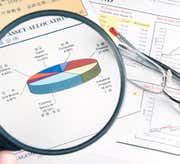|

|
The first step in the DCF analysis process is to determine how far out into the future you should project cash flow.
The Forecast Period
For our example, we’ll assume that ACME Corp. is growing faster than the gross domestic product (GDP) expansion of the economy, and it will be able to earn returns on new investments that are greater than its cost of capital during this excessive return period. Since most companies can’t grow faster than the economy for long, we have to estimate how far into the future this period of excess returns will last (it’s common practice to use the excess return period as the forecast period).
To do so, we’ll make an educated guess based on the company’s competitive and market position, with the assumption that all companies settle into maturity and slower growth. Even though we’re using the excess returns period in our example, it’s important to note that you could also use DCF analysis to value a company that’s growing slower than the economy.
Here are some general guidelines to use when determining a company’s excess return period or forecast period, based on the company’s competitive position:
|
Company’s Competitive Position |
Excess Returns/Forecast Period |
|
Slow-growing; operates in a highly competitive, low-margin industry |
1 Year |
|
Solid company; has advantages such as strong marketing channels, brand recognition and/or regulatory advantage |
5 Years |
|
Outstanding growth; operates with high barriers to entry, dominant market position or prospects |
10 Years |
For our example, we’ll assume that ACME Corp. has strong marketing channels, solid brand recognition and a reasonable competitive position. But – even though there’s enough demand to support five years of growth – we anticipate the market will be saturated after that point. As such, we’ll project our cash flows over the next five years of business.
Revenue Growth Rate
Now that we’ve decided on a five-year forecast, we need to estimate the company’s free cash flow growth over that period. We start by forecasting revenue growth.
As we make revenue projections, we need to think about what ACME Corp. – and the industry – could look like as they evolve over the next five years. It’s important to consider such factors as whether the company’s market is expanding or contracting, its market share numbers, whether there are any new products driving sales and if pricing changes are anticipated.
Because this is a lot of guesswork, it can be helpful to consider more than one scenario. As such, we’ll calculate two different revenue growth models: one that’s optimistic, and says the company will continue to grow at a rate of 20% per year. The other profile errs on the side of caution, and assumes 20% growth during the first two years, 15% growth for the next two years, and 10% growth in Year 5. Assuming present annual revenues of $100 million, our forecast revenue growth profiles will look like this:
|
|
Current Year |
Year 1 |
Year 2 |
Year 3 |
Year 4 |
Year 5 |
|
Optimistic Revenue Growth |
- |
20% |
20% |
20% |
20% |
20% |
|
$100M |
$120M |
$144M |
$172.8M |
$207.4M |
$248.9M |
|
|
Conservative Revenue Growth |
- |
20% |
20% |
15% |
15% |
10% |
|
$100M |
$120M |
$144M |
$165.6M |
$190.4M |
$209.5M |
Now that we have a forecast period and revenue growth forecasts, the next step is to estimate the free cash flow generated over the forecast period.
DCF Analysis: Forecasting Free Cash Flows
-
 Investing
InvestingEvaluate Stock Price With Reverse-Engineering DCF
This is a more accurate method to use when trying to find a target price for a stock. -
 Investing
InvestingDCF Valuation: The Stock Market Sanity Check
Calculate whether the market is paying too much for a particular stock. -
 Investing
InvestingTaking Stock Of Discounted Cash Flow
Learn how and why investors are using cash flow-based analysis to make judgments about company performance. -
 Investing
InvestingRevenue Projections Show Profit Potential
Examining how a company makes money can offer clues about its earnings potential. -
 Investing
InvestingFree Cash Flow Yield: The Best Fundamental Indicator
Cash in the bank is what every company strives to achieve. Find out how to determine how much a company is generating and keeping. -
 Investing
InvestingCorporate Cash Flow: Understanding the Essentials
Tune out the accounting noise and see whether a company is generating the stuff it needs to sustain itself. Learn how to read the cash flow statement.


